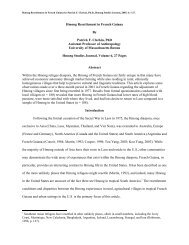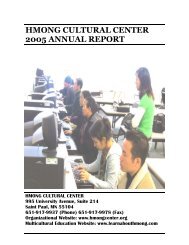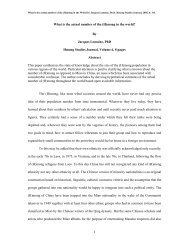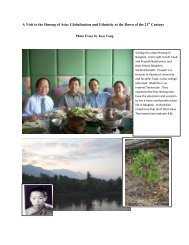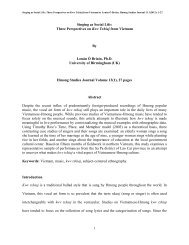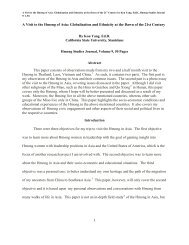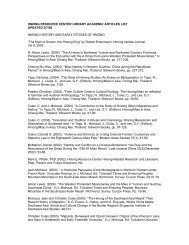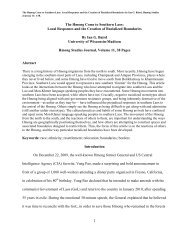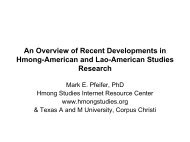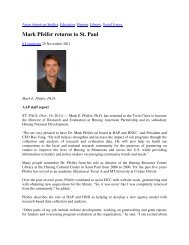Hmong and Lao Refugee Women - Hmong Studies Internet ...
Hmong and Lao Refugee Women - Hmong Studies Internet ...
Hmong and Lao Refugee Women - Hmong Studies Internet ...
Create successful ePaper yourself
Turn your PDF publications into a flip-book with our unique Google optimized e-Paper software.
<strong>Hmong</strong> <strong>and</strong> <strong>Lao</strong> <strong>Refugee</strong> <strong>Women</strong>: Reflections of a <strong>Hmong</strong>-American Woman Anthropologist by Dia Cha, Ph.D. <strong>Hmong</strong> <strong>Studies</strong> Journal,<br />
2005, 6: 1-35.<br />
The sleeping area of these long houses was originally built as an open space, running from one<br />
end of the structure to the other, <strong>and</strong> most houses incorporated a long wooden "mattress" that spread from<br />
one wall to another of this open space. With no dividing wall to furnish nocturnal privacy, most refugees<br />
had constructed makeshift partitions of blankets, plastic sheets, woven bamboo, or what have you, to<br />
isolate somewhat the portion of sleeping platform allocated to each family unit.<br />
In many ways, the quality of life in the refugee camps had, of necessity, been affected by<br />
crowding, a factor which very naturally grew in significance as populations increased. Chieng Kham<br />
camp was more crowded than Napho, so that the long houses were closer to each other <strong>and</strong> there was no<br />
space for gardening or for use as a playground for the children. Perhaps not surprisingly, the fence<br />
around this camp was also more secure <strong>and</strong> the Thai guards more alert <strong>and</strong> watchful for any attempt at<br />
escape. Only refugee leaders, <strong>and</strong> those in need of medical treatment, were given permission to leave<br />
camp. Napho, meanwhile, being somewhat less crowded, featured more space between houses,<br />
playgrounds for the children, <strong>and</strong> gardening space for adults. In addition, during the day refugees could,<br />
after securing permission from camp authorities, go shopping in the nearby town.<br />
Children were much in evidence in both camps; in fact, UNHCR estimated that fifty percent of<br />
camp residents either were born in Thail<strong>and</strong> or fled <strong>Lao</strong>s "when they were too young to remember the<br />
country. Few had direct experience of the war or of persecution" (UNHCR Chieng Kham <strong>and</strong> Napho<br />
<strong>Refugee</strong> Camps Briefing Papers, 1992:2).<br />
Another factor common to both camps was the authority ultimately responsible for the manner in<br />
which they were run; both Chieng Kham <strong>and</strong> Napho were administered by the Thai Ministry of Interior<br />
(MOI) – a branch of the Royal Thai government. MOI staff representatives, all Thai nationals, were<br />
present in both camps, <strong>and</strong> each camp was headed by a Camp Comm<strong>and</strong>er responsible both for the<br />
management of daily affairs <strong>and</strong> for camp security. In these tasks, MOI staff members collaborated with<br />
UNHCR <strong>and</strong> NGO representatives, <strong>and</strong> consulted with delegated refugee leaders or directly with refugee<br />
committees (UNHCR Chieng Kham <strong>Refugee</strong> Camp Briefing Paper, 1992, <strong>and</strong> The CCSDPT H<strong>and</strong>book,<br />
1986). While MOI administered justice within the camps, <strong>and</strong> reserved the right to make all final<br />
6




